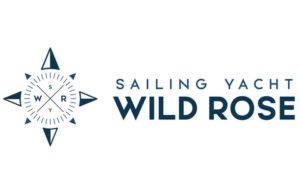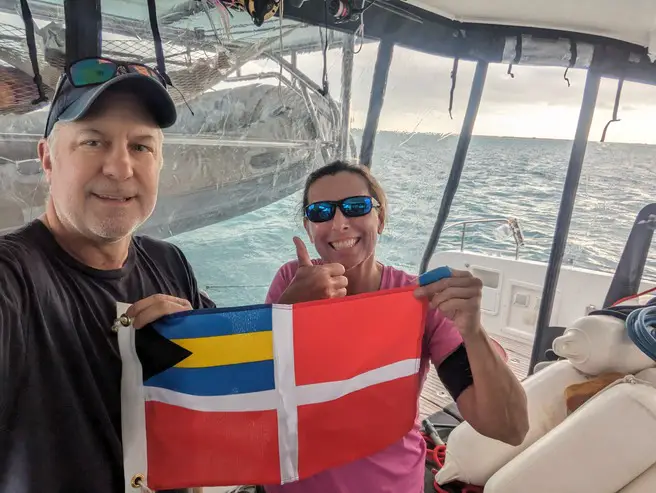It’s 90 percent boredom and 10 percent sheer terror.
John Casey
Moving down the Florida coast…lights, lights, and more lights
Our last update was from Wrightsville, NC and as weather windows opened up we continued south to Fernandina Beach, FL (Amelia Island). We anchored near this adorable town for a week over Christmas while waiting for our new AIS (Automatic Identification System) to arrive. Just before we left Virginia our AIS transceiver broke (bummer) but we left anyway. We could “see” other boats on AIS but they couldn’t see us (not horrible, but much more comforting when you know they can “see” you). On Dec. 30 it arrived to the UPS Store, we got it installed, and we left Fernandina Beach at midnight. That was a first. Picking up anchor in complete darkness and motoring out of the channel with me at the bow with a spotlight watching for crab pots and Jason at the helm.
Seeing all the navigation lights while sailing down the Florida east coast at night can be a lot to visually digest. There are so many navigation lights blinking at different intervals peppering the coastline and mix that with identifying other ships in the area and it’s attention getting. It can be a challenge but you can turn it into a bit of a game. For example…Out of the 15 red blinking lights near the shore which is about 10 miles away, find the one that’s blinking at a 6 second interval (not 2 seconds, not 4 seconds). Because that’s the one you really need to avoid. Good luck!
We arrived into West Palm Beach, FL (aka Lake Worth) on Tuesday morning (3 nights of sailing/220 miles). More about sailing at night in a bit. Lake Worth is a HUGE anchorage area where almost no one follows the rules of courteous boating. No Wake sign? Please, that’s just a suggestion. Let’s zoom by that sign at 30 mph. Why did we sail down to West Palm? That was our ‘jumping off’ point to the Bahamas. The further south you can go in Florida, the better for crossing the Gulfstream because the Gulfstream pushes you north while you’re trying to sail east.
What’s it like sailing at night?
It’s dark. It’s not like driving a car at night with headlights. If there’s a moon it’s a treat to have the moonlight shining down offering a hint of light. The stars are beautiful. Sailing at night is an absolutely amazing experience and sensation. For me it feels like being in a state of calm but sustained high-alert. You’re sitting at the helm by yourself (we do 3 hour watches at night) and all of your senses are amplified – you learn to hear the wind, the sounds of the boat, the sounds of the sail, the water rushing by. You can’t see the water but you can hear it. You rely on your eyes to spot other boats’ lights, and navigation instruments to guide you. We use our built-in navigation system at the helm station plus a tablet mounted at the helm station for redundancy. We also have our navigation programs on a few other tablets and our phones. We use Navionics and Aquamaps for navigation, plus PredictWind, Windy and a few other apps for routing and wind. But most important is your own eyes—you gotta look around at minimum ever 10-15 minutes because cargo ships and passenger cruise ships can come up on you quickly. One more thing about night sailing… if you’re on the sunrise shift it’s one of the most glorious things to watch the sunrise. It’s such a wonderful uplifting feeling to see the glow on the horizon and experience fully the start of a new day.
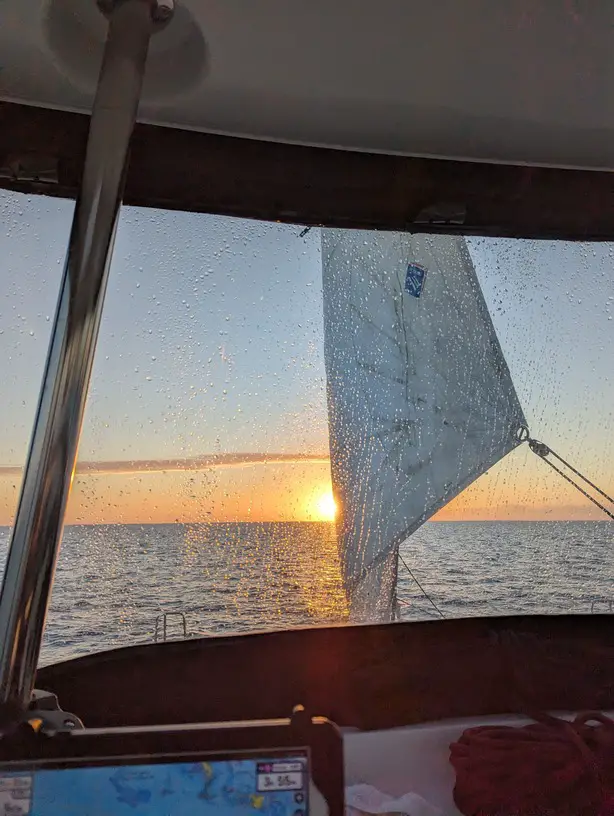
Communication is key: Using Milo communicators
Just a brief bit on how we communicate with each other during activities such as anchoring or putting up a few of our sails that require us to be at opposite sides of the boat where we can’t see each other. (there’s a reason I’m mentioning this) While anchoring, Jason is typically at the helm and I’m on the bow of the boat managing the anchor. We’ve used Sena headsets in the past and have just stared using Milo communicators. We wear them on armbands and it allows us to talk to each other while we’re about 15 feet apart separated by a helm enclosure and often it’s windy where I’m standing. It eliminates needing to shout to be heard. It only takes about a minute to get them turned on. In the sailing community they’re often called marriage savers & I 100% agree.
Crossing the Gulfstream & sailing on the Little Bahamas Bank… It’s no joke. It’s tough. And then it’s FANTASTIC
About 5 minutes after we got into Lake Worth, Jason saw that a really good weather window to cross the Gulfstream would open the next morning at sunrise. We’d hoped to just relax for a few days after a very bumpy night of sailing. But, no. We picked up anchor at sunrise and headed out—destination… Bahamas. Finally. The Gulfstream is about 45 miles wide at the section where we crossed and we saw current ranges from .5 knots of current at the very edges up to 3.2 knots. The current pushes you north, while you’re trying to get east, so naturally we ended up more north which we expected. It took us about 15 hours to fully cross the Gulfstream (where depths are thousands of feet) and get onto the Little Bahamas Bank (where depths are less than 20 feet). What was it like? It wasn’t scary, just really, really bumpy. It was like riding a see-saw horse for 15 hours. The first 2 minutes are fine and then you just want it to stop. When we finally got onto the Bank we thought it would immediately calm down… but nope. The see-sawing continued for a few more hours and let me tell you… when it finally calmed down and we were just sailing along in silence, it was pure bliss. The sunrise brought champagne sailing and bright turquoise waters.
Calling a cargo ship to alter course & Fish-On!!
Of course, nothing happens for HOURS on end and then a few things happen at the same time. The setting… we’ve had our fishing poles out all day, no action. We’re under full sail, it’s just before sunset, we’re on the edge of the Gulfstream about to get onto the Little Bahamas Bank, we’re hobby horsing up & down, the wind angle is just so we don’t have a lot of wiggle room to turn, and we see a cargo ship on a collision course with us. It’s not super close yet, but close enough. We call them on the VHF radio and ask them to alter course. They do and while we’re still keeping a close eye on our courses to ensure we’re not in danger, the reel goes crazy! First time we’ve had any fishing action all day. We slow down a bit, I reel in the other line, and Jason reels in a really nice size wahoo! Hooray! So beautiful and delicious. This fish will provide about 10-12 meals. Our freezer was 90% full when we left the States and now it’s so full we can barely close it.
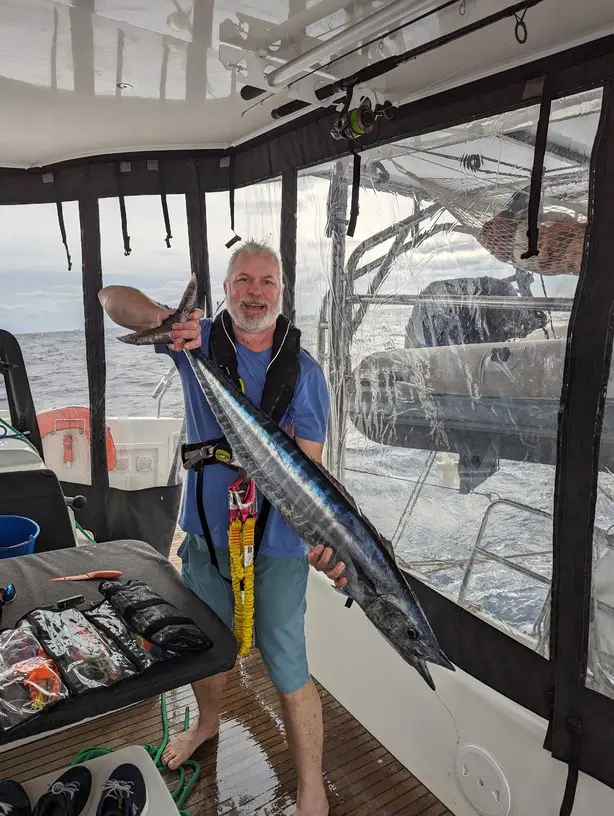
The Shit Storm… did you see the quote at the start of this?
Ok, back to sailing on the Little Bahamas Bank. What a beautiful day! Such perfect wind, clear skies, turquois water that we decided to put up one of our new sails (not the first time we’ve flown it, but we’re still learning it for sure). This is our asymmetrical spinnaker. Very large and lightweight sail meant for light downwind sailing. These types of lightweight sails can be flown in a max of up to 15 knots of Apparent Wind. We knew the wind was expected to build a bit in the afternoon, but we didn’t expect it to be so fast. This sail is furled/brought in by pulling on a line by hand near the port bow of the boat while the other person slowly lets out a line from the back of the boat. If you’re the person at the bow, it’s just grab with both hands & pull like a rowing motion until the sail is all furled up nicely. This usually takes about 5 min. It normally requires strength (especially grip & forearm strength), but not superman strength.
Several things happened very quickly that led to the most terrifying moment we’ve experienced. We were entering a slightly narrower area where we needed to turn slightly to stay on our course (we’re leaning in the Bahamas that a navigation route is not a suggestion, it’s really important to stay true to the route and watch your depths because there are so many super shallow areas). There was a boat following us. The wind picked up so quickly we didn’t have time to get our communication devices on. The apparent wind went from 14 knots to about 22 knots. Jason didn’t have time to put on his sailing gloves. I went up to the bow to furl in the sail like I’ve done before. No luck. Jason came up & we sat one behind the other & in unison pulled and pulled. Minimal progress. Jason stayed on the bow & I went to the stern to pull the line from there in coordination with Jason while letting out one of the lines little by little. It’s howling wind, we can’t hear each other. At some point during this 20 min shit show episode I get slammed in the temple by a line and we both realize while pulling on the furling line that we’ve both ripped skin off our fingers and there’s blood. But, stopping isn’t an option. It’s painful to pull on the line and you know it’s going to hurt each time but getting this f’ing sail furled is the singular goal at this point. You may wonder, why not just turn up into the wind to get the sail down? Not an option with this huge sail. So, we finally get it brought in. Took about 20 minutes. Our forearms are burning. Felt like a lifetime. We then bring the main sail down & decide to just motor the last hour. We finally sit down to re-group. We’re both shaken, our hands look like something chewed on them. Jason informs me my temple is bleeding. I go get the medical kit & we get everything clean and bandaged. We talk about what we did wrong – we know we messed up. We waited too long to take the sail in, didn’t have our communication devices on, didn’t have proper gloves. We both agree it was terrifying & that’s not a word either one of us ever want to use again. We will never forget these lessons.
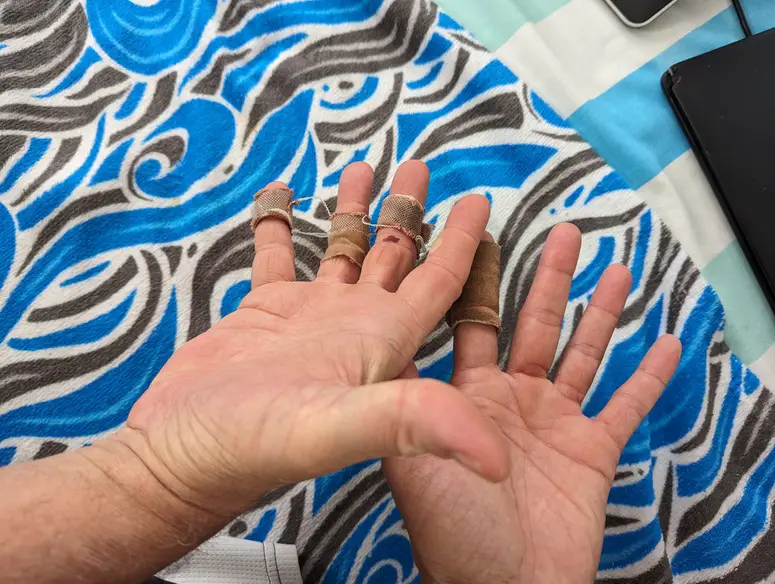
Ok, back to the happy times… and of course… More Dolphins & a baby dolphin
After 20 hours/160 miles we got safely anchored at Manjack Cay, an island in the northern Abacos to rest for the night. The next day we officially checked into the Bahamas at Green Turtle Cay. The Bahamas include over 700 islands & cays (pronounced “keys”) and stretch over 500 miles from north to south. We’re currently in the northern part of the Bahamas called The Abacos. We have to move almost daily in order to have wind protection each night at anchor. It’s an El Nino winter which means there are more fronts more closely together that bring more wind in a constant clockwise direction. What this means is that you have to find protection from the north & east winds one day & then move to snug up near another island that will give you protection from the south and west. After one of the days of moving to a new anchorage for the night, we were sitting in our salon having coffee in the early morning, it was super quiet & then we heard a splash right behind the boat. We were treated to a mama dolphin and her little baby swimming around the boat. The baby was glued to her side almost as if the baby was learning to swim and breath. Amazing.
One of the trials of moving southward in the Abacos is getting through The Whale Cut. It’s basically an area you have to go through in order to keep going south. It can be gnarly on the wrong day. Jason chose a perfect day to transit it– westerly winds, waves only 4-5 feet with 11 second interval– and then we anchored at Great Guana Cay and went ashore to check out the 2 famous bars – Nipper’s (tropical nightclub vibe) and Grabber’s (on-the-beach chill vibe). We’re Grabber’s people. We’re now at anchor at Elbow Cay. Yesterday we went into check out the Elbow Reef Lighthouse. We climbed up the 100+ stairs to the top. It still has the original Fresnel lens and there were jugs of kerosene inside as it’s still active.
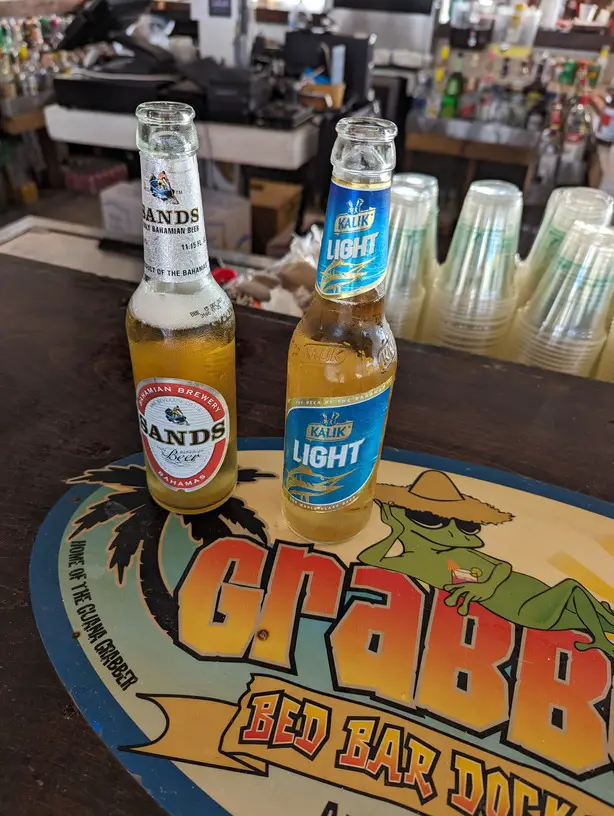
We’ll sit here at anchor today while a gusty blow (26 knots/gusting to 36) passes by. Eventually we’ll map out the next jump likely down to Eleuthera (a group of islands south of the Abacos). Feeling grateful and humbled.
Ship Log
Sign up below to be added to our email list for the Ship Log. We only post once or twice a month.
